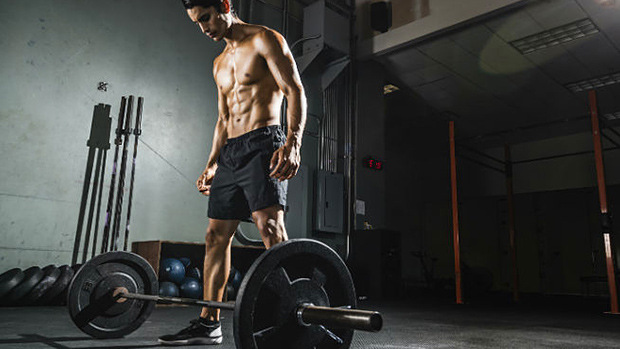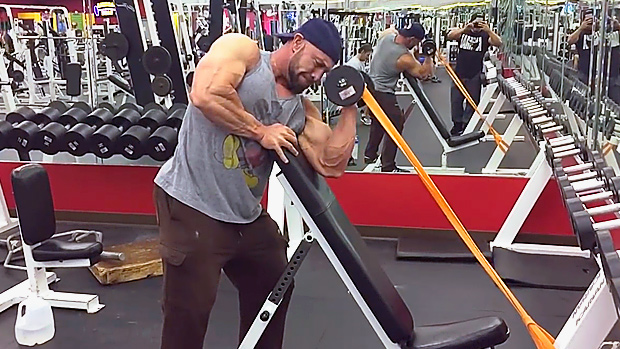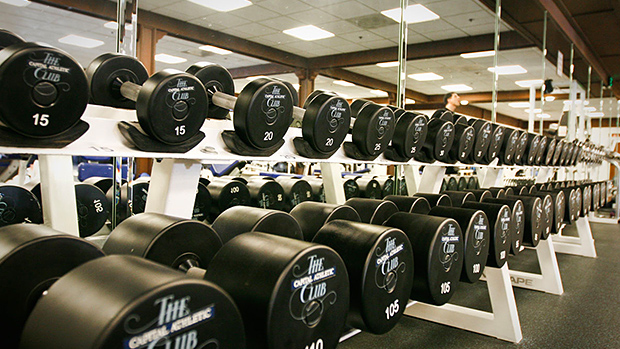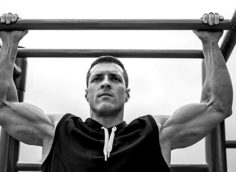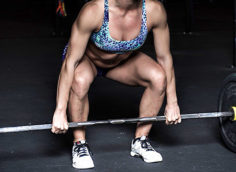- "I suck at squatting because I'm too skinny!"
- "My bench is weak because of my long arms!"
- "My deadlift will never go up. I'm just not built to pull heavy!"
Ever hear a training partner utter one of these lines? Or, worse yet, have you ever said these things yourself? If so, we're here to give you a fresh outlook on ways to improve your lifts.
Biomechanics buffs like us are always looking for scientifically applicable ways to improve our lifting. In this article, we're going to give you some new insights as to possible areas of weakness, as well as ways to address these weaknesses to take you to newfound levels of strength and performance!
Research in the Trenches
When you think of research, an image of nerdy scientists in lab coats probably comes to mind. But it's important to remember that research doesn't have to take place in such a formal setting, nor does it need to be reported in a way that only nerdy scientists can understand it. While the world of strength and conditioning does have considerable formal research to it, it's also notorious for knowledge that's come from "under the bar" research.
Perhaps nowhere is this more readily apparent than in some of the world's most hardcore and knowledgeable powerlifting gyms. Good lifters are always looking for ways to get stronger. To ensure future success, what better way is there than keeping track of what's worked for you and what hasn't?
With that in mind, we decided to pick the brains of over thirty accomplished powerlifters on training for your body type. All lifters had a minimum Class 1 total in their respective federations, essentially eliminating the possibility of "newbie gains" confounding our results. From there, we looked for trends to back up our observations and what we felt was going on from a biomechanical standpoint.
The Weakest Link Theory
For years, performance coaches have applied the "weakest link" principle to their training: find the weakest link, bring it up, and watch your lifts grow. Pretty simple, isn't it?
Seemingly, but until this time, it's always been a little bit more trial-and-error than we'd prefer. We're science geeks; we want something we can count on to work time and time again. Our goal is to apply the weakest link principle in a scientific fashion based on our own experience, as well as those with whom we've trained and conversed.
When you're trying to loosen a bolt, a long lever arm is of great value because it improves your torque. Improved torque will decrease the amount of force you need to apply to get the bolt off. However, when you apply this to lifting, long levers aren't conducive to big lifts!
Think about the poor schmuck who has ape-like arms and legs trying to squat or bench (i.e. the authors of this article!). Chances are that he isn't moving nearly as much iron on these lifts as the guy in his weight class who's six inches shorter, a foot thicker, and has a torso that resembles a small-block Chevy. However, put the bar on the floor, and "Ape Arms" will own "Stumpy" when it comes time to deadlift.
Obviously, this is nothing new, but how can we train these weaknesses to improve our individual lifts and total? The force-velocity curve holds a lot of the keys to this answer, so let's discuss its implications on our performance.
Are You a Ferrari or a Mack Truck?
This might be a somewhat elementary analogy, but think about the difference between a Ferrari and a Mack truck. A Ferrari has a great top-end speed, but doesn't have that slow, grind-it-out type of power. On the flip side, a Mack truck can tow just about anything, but doesn't have the ability to hit very high speeds.
What the hell does this have to do with lifting? More than you might think!

The force-velocity curve tells us a lot about our lifting. In essence, the curve says that the lighter the weight, the greater the velocity with which we can move it. On the flip side, if something is very heavy (like a 1RM), the velocity we'll produce is going to be much lower.
The force-velocity curve will also give us some insight as to the relationship between speed and strength. Think of speed and strength as a continuum (depicted below with examples). On the left end you have absolute speed. On the right side you have absolute strength. In between, however, you have the intermingling of the two.
< ———————————————————————————————————— >
| Absolute Speed | Speed-Strength | Strength-Speed | Absolute Strength |
| Countermovement Jump, Sprinting | Jump Squats at 30%1RM | Speed Squats at 60% 1RM | 1RM Squat |
As you get closer to the left side, you'll display a high degree of speed, with strength being a secondary factor. On the right side of the continuum, speed won't be as prevalent as strength. We'll describe later how the speed-strength continuum can be applied to your lifting for maximal results.
Bringing It Together
Okay, so most of us have bad levers in one of the lifting disciplines. If you're a squatter/bencher, you'll have more trouble deadlifting. Conversely, if you're a deadlifter, squatting and benching will be tougher for you. So let's examine how we can train these lifts in a scientific fashion to put consistent pounds on your total.
Squatting and the Long Limbed Lifter
The long limbed lifter typically has a short back/torso and long arms and legs. For this reason, the legs will typically be the weakest link when squatting. In fact, both of us have this type of body style and have had great results by strengthening the legs with less attention devoted to the lumbar erectors. The back is the shorter lever and will typically be very strong.
Moreover, because the torso is shorter, it's more difficult for a lifter of this build to arch on the bench and squat to limit range of motion and improve the mechanical advantage. So how do we drive those squatting numbers up?
Solution #1: Train for Speed-Strength
When squatting, the long limbed lifter will commonly miss at roughly halfway up before he stalls out. The torque around the knee joints will produce a significant amount of elastic energy, which makes for great rebound out of the hole. When this elastic energy runs out, however, it's up to the lifter to finish the lift.
This is where accommodating resistance comes in, as it simulates "hitting the brick wall" when your stretch reflex assistance goes down the tubes. This can also get tricky with the inclusion of squat suits into the equation. The added rebound and momentum he gets out of a suit can really aid this lifter in his pursuit of a bigger squat.
Accommodating resistance such as bands and chains will prove invaluable for the long-limbed lifter, as it'll teach him to be super explosive and blast through sticking points. Bar weight should be low, but a large amount of band and chain tension should be included. We aren't looking to grind out the reps; we want to focus on getting out of the hole with a lot of pop, and then accelerate as quickly as possible to the completion of the lift (acceleration strength). Effectively, we want to "outrun" the bands and/or chains.
Solution #2: Strengthen the Legs
It makes sense that if our arms and legs are our longest levers, we need to strengthen them to a high degree to improve our lifts. Think about the long-limbed lifter squatting. Chances are at some point his chest comes over slightly due in part to the fact that the shorter torso won't allow for as significant an arch. Obviously, it might also be due to weakness, but it's more likely related to the fact that his legs aren't as strong as his lower back.
As he blasts out of the hole, the weaker legs shift the weight to the stronger lower back to finish the lift, turning the squat into a good morning. It's simply a matter of the body trying to find the most efficient way to finish the lift.
To drive up the squat, you need to strengthen the glutes, hams, adductors, and quadriceps without allowing the lower back to take over the movements. Exercises to include here would be lunges, step-ups, glute-ham raises, pull-throughs (arched back for glute emphasis), stiff-leg deadlifts, kneeling squats, and any other exercise that puts the majority of the loading on the legs and glutes rather than the low back. Landon Evans, who squatted 611 in the 198 pound class as a teen, cites Bulgarian squats (another leg-dominant exercise) as a great exercise for building his squat to mammoth levels.

Bulgarian Squat
Extra lower back training is rarely necessary for these trainees. We know that we need to bring up the overall strength of our legs, so why would we devote a ton of time training what's already our strongest link? Exercises like good mornings and back extensions would benefit this lifter from a "chaos training" standpoint, meaning that it would help him to save lifts that get out of the groove. Beyond that, however, he's probably not going to get too much out of them.
Solution #3: Improve your Arch with Dedicated Flexibility Work
Just because you have a short torso doesn't mean that it isn't possible to improve the ability to arch. Obviously, this is of more importance to those who are competitive in the bench press, but everyone can see some great powerlifting-style squat improvements by mastering the arch.
If you want to improve your arch, work on lumbo-pelvic flexibility with all the stretches outlined in Hardcore Stretching: Part 2 and, obviously, practice arching – even if there's only 135 on the bar. You can also check out Mike's Heal that Hunchback! article, as using PVC pipe can be an invaluable tool to developing a better arch (although it's not recommended for all populations).
Solution #4: Train the Top End
It makes sense that if we train our weakest muscles, we'll improve our total. However, the same can be said for training the weakest portion of the movement. In the case of this lifter, good mornings and/or Anderson squats at the mid-range position (from pins or chains) would be of great benefit.
The work from this position will be of benefit because you're working from a dead-stop, overcoming it with a concentric effort, all at your weakest point in the lift. Hard work, but it'll definitely be beneficial to your total.
Squatting and the Long Torso Lifter
The long torso lifter obviously has the advantage when it comes to squatting. It's simply a lot more appealing to the eye to watch someone like this squat! The movement can seem lightning quick because his range of motion is so short.
However, getting stuck "in the hole" is usually where this lifter misses. If he can get the weight out of the hole, he can typically finish the lift. This point, however, is where he can see some benefits from correct application of our ideas.
Solution #1: Strengthen the Lower Back
As the lifter approaches the top portion of the lift, he's typically far more upright than his long-limbed counterparts. Therefore, the long torso lifter will use a mixture of trunk/hip extension to complete the lift.
Assistance lifts like Romanian deadlifts and good mornings are excellent options for these lifters, as they mimic the same trunk/hip extension necessary to complete the lift. Moreover, any exercise that strengthens the lumbar erectors is of high priority, as these lifters rely on a tight arch to maintain the upright position.
Solution #2: Train for Strength-Speed
As we noted earlier, a lifter with a long torso and short legs needs to focus on getting more "pop" out of the hole. Focusing on strength-speed can destroy this sticking point since you're putting a greater emphasis on plate weight rather than chain or band weight. Remember, chains and bands load up the top portion of the lift, while plate weight will put a greater emphasis on the bottom portion. This can also allow you to learn to make up for a lack of speed with low-end, grind-it-out strength.
Lifters with the longer torso body type should include a large amount of bar weight, accompanied by some light chains or bands. Two such lifters are Jay Floyd and Ross Bowshers, both of whom have squatted 800+ in the 275 pound class. These guys agree that strength-speed has yielded much greater improvements in their squat than speed-strength, which hasn't done much for them at all. If a triple body weight squat doesn't convince you, then you're just not going to be convinced!
Now keep in mind that just because you'll get more benefit out of training either speed-strength or strength-speed doesn't mean you should neglect the other altogether! Variety is the spice of life (and training), so make sure to implement multiple applications of the F-V curve into your programming. The secret is to understand that some points on this curve should be used more frequently than others.
Okay, that's enough "science behind lifting heavy stuff" for now. In Part II, we'll discuss how your leverages affect your bench and deadlift training. Until then, try out some of these concepts and see how they can improve your total!

